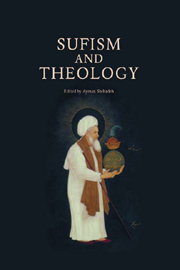Book contents
- Frontmatter
- Contents
- Contributors
- Acknowledgements
- Introduction
- Part I Mystical Theologies
- Part II Theological Approaches to Sufism
- 6 The Mystic and the Sceptic in Fakhr al-Dīn al-Rāzī
- 7 Ibn Taymiyya's Commentary on the Creed of al-Ḥallāj
- 8 Ibn Kemāl (d. 940/1534) on Ibn 'Arabī's Hagiology
- 9 Scriptural Sufism and Scriptural Anti-Sufism: Theology and Mysticism amongst the Shī'ī Akhbāriyya
- 10 Reconciling Sufism with Theology: Abū l-Wafā al-Taftāzānī and the Construct of ‘al-Taṣawwuf al-Islāmī’ in Modern Egypt
- Index
6 - The Mystic and the Sceptic in Fakhr al-Dīn al-Rāzī
from Part II - Theological Approaches to Sufism
Published online by Cambridge University Press: 12 September 2012
- Frontmatter
- Contents
- Contributors
- Acknowledgements
- Introduction
- Part I Mystical Theologies
- Part II Theological Approaches to Sufism
- 6 The Mystic and the Sceptic in Fakhr al-Dīn al-Rāzī
- 7 Ibn Taymiyya's Commentary on the Creed of al-Ḥallāj
- 8 Ibn Kemāl (d. 940/1534) on Ibn 'Arabī's Hagiology
- 9 Scriptural Sufism and Scriptural Anti-Sufism: Theology and Mysticism amongst the Shī'ī Akhbāriyya
- 10 Reconciling Sufism with Theology: Abū l-Wafā al-Taftāzānī and the Construct of ‘al-Taṣawwuf al-Islāmī’ in Modern Egypt
- Index
Summary
INTRODUCTION
By the 6th/12th century, it was possible to discern a number of well-established and well-developed religious and intellectual traditions offering distinct ‘approaches’, or ‘methods’ (ṭarīqa) to metaphysical knowledge and human salvation. Although these traditions, of course, overlapped greatly in their constituencies and were at that stage undergoing a process of increasing inter-tradition eclecticism, they typically had devoted ‘partisans and adherents’ (ahl), who often would be more or less antipathetic to other traditions. Just as schools within the same tradition vied with one another, traditions too were often in competition. Hence, while Mu'tazilīs and Ash'arīs were at loggerheads, they nonetheless shared the designation ‘ahl al-kalām’ and represented ṭariqat al-kalām. Members of both schools defended not only their school doctrines, but likewise their practice of kalām.
Among the accusations frequently levelled at the mutakallimūn by an array of their critics – Sufis, traditional theologians and philosophers alike – is that they have a propensity to doubt (shakk) and perplexity (ḥayra). The mutakallim claims to offer a path to certitude (yaqīn), the charge goes, but engages merely in controversy and raising doubts against others. When he himself becomes prey to doubt, he becomes the living proof for the failure of his method.
This impression will have been consolidated by al-Ghazālī's (d. 505/1111) well-known assessment, in al-Munqidh mina l-ḍalāl and elsewhere, of the four main current approaches to metaphysical knowledge – kalām, philosophy, Ismā'īlī instruction and Sufism – and his conclusion that genuine certainty is attainable through Sufism, whereas kalām may only serve a subsidiary role.
- Type
- Chapter
- Information
- Sufism and Theology , pp. 101 - 122Publisher: Edinburgh University PressPrint publication year: 2007



